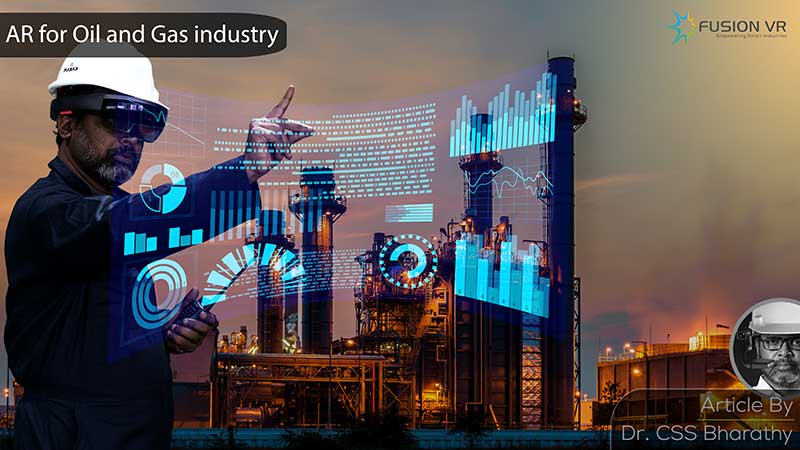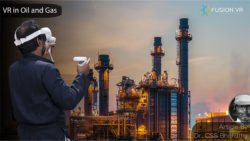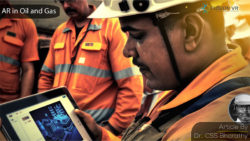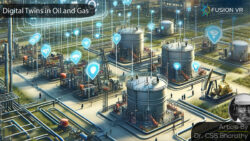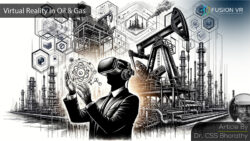Augmented Reality and Virtual Reality are two of the key technologies that are ushering in the Fourth Industrial Revolution. Known as Industry 4.0, this latest instalment of the industrial revolution promises the transition to smart factories and smart manufacturing. The Oil and Gas industry is one of the foremost industries that drive the nation’s economic growth. The energy security of a nation depends on this industry and, with it, the ability to stay competitive in the global economy.
The competitiveness of any industry has a direct correlation with the quality of its human capital. The ability to attract and retain top talent is crucial in today’s world. Companies compete with each other in this arena as today’s economy is highly knowledge driven. Augmented reality and virtual reality are, in fact, the only technologies in Industry 4.0 that are capable of enhancing and elevating the level of human performance.
Both these technologies help to develop the capabilities and competencies of employees to higher levels leading to improvements in productivity, increased efficiency and better return on investment.
If you’re an industry professional engaged in oil and gas operations, maintenance or reliability, this would certainly perk up your interest. If you happen to be at the leadership level, this is definitely an area you would wish to engage your teams in to explore the potential and tap into its advantages.
The Use of AR and VR for Training Employees in the Oil and Gas Industry
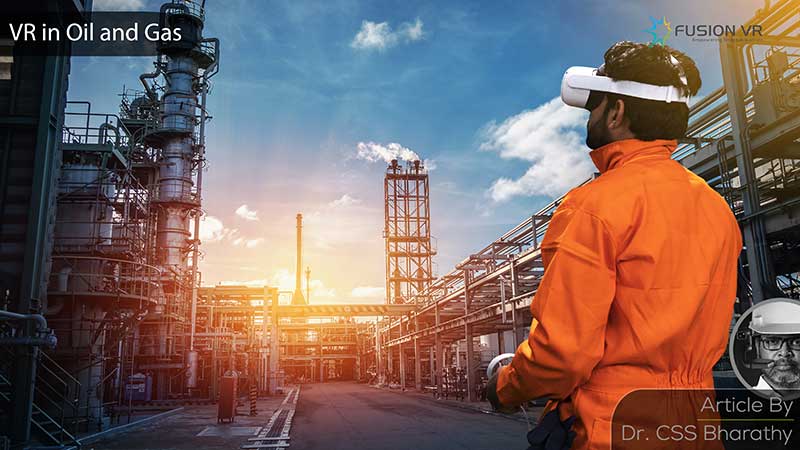
For everyone in the industry, it’s not just knowing the huge potential of AR and VR in the oil and gas industry. It is more important to understand the various use cases and see how they can be deployed in your organisation.
The first use case that we can look at is the use of AR and VR for training employees in the oil and gas industry. Human error has been and would probably be one of the leading causes of safety and reliability issues. This root cause has led to injuries, fatalities, reportable emissions, and unplanned outages that have caused several million dollars in losses.
Most of you may remember the Deepwater Horizon accident in 2010 that led to the loss of 11 precious lives and the release of nearly 5 million barrels of oil, which caused what is probably the worst environmental disaster in human history. This was the result of human error and poor decision-making, which could have been avoided with better training and leadership.
The use of augmented reality in oil and gas companies is detailed here. AR is deployed using wearables such as AR goggles to provide guided learning solutions designed to develop strong competencies for all high-risk and critical activities engaged by operators, technicians and engineers.
Such applications are used to reinforce the right sequence and accuracy of tasks to ensure the right outcomes every time. Unexpected errors by individuals often result in irreversible consequences. Training with AR tools reduces the incidence and impact of injuries, outages and asset damage. AR simulators and remote assistance solutions are gaining rapid acceptance worldwide.
VR, on the other hand, takes practical training to a wholly new level with its capability to deliver total immersiveness. The use of virtual reality in the oil and gas industry is growing rapidly due to some inherent challenges. Oil and gas facilities present many challenges and are mostly located in remote locations.
Training employees generally consumes a lot of time, and they typically are not allowed to independently operate major equipment and processes unless they undergo rigorous training and certification processes. This is because of the nature of hazardous materials used and the complexity of the process.
The potential of AR technology in remote support for the oil and gas industry
VR solutions such as VR-OTS, the Virtual Reality Operator Training Simulator, recreate an offshore oil platform that completely and accurately represents every pipe, instrument and equipment realistically in the three-dimensional virtual environments. Trainees using VR controls navigate and operate everything that a real operator does in a real plant.
VR training in oil and gas provides the experience of being in a real plant which otherwise is quite time-consuming and requires the need for experienced training personnel. The VR-OTS use case is quite spectacular and is currently deployed in both academia and industry. Fusion VR is a pioneer and partnered with Yokogawa in implementing one of the first such simulators.
The above two use cases have the potential to transform the way employees are trained. It has been found that it increases engagement and confidence in employees. Such positive outcomes deliver improved productivity, safety training and performance, operational efficiency and reliability.
The next important use case is with AR and remote support. The oil and gas industry is capital-intensive and deploys highly sophisticated machinery and equipment to conduct its operations.
Many of the oil and gas installations are in remote or offshore locations. When issues occur, there is usually a small team that attends to them. In the event the issues are more complex, a team of engineers or an expert is mobilised to the site to troubleshoot and fix the problem.
Though advanced telemetry and communication systems provide the data for analysis, there does come the point where certain assets and components need to be replaced. They need to be done right, and an expert may not be able to get there quickly. Sometimes, it may take even a week to mobilise them to the site.
This is also due to security clearances and travel constraints depending on the global location of this asset. AR is now helping to solve this problem quite effectively. The local team is provided with live instructions through AR wearables such as goggles that allow the expert to see exactly what the technician is seeing and provide step-by-step guidance on the actions required.
The technician would be able to see textual and graphical information overlaid on his/her screen that is quite the same as someone providing the instructions standing next to them. The wearables are also intrinsically safe (IS) for working in hazardous environments. The technician and expert remain in close two-way contact till the issue is resolved to satisfaction. This use case brings down costs tremendously for any organisation while improving productivity and ROCE.
The use of AR and VR in the exploration and design processes
The final use case that we need to look at is the use of AR and VR in the exploration and design processes. VR delivers improved visualisation of seismic data obtained from geological studies. This has reduced the time to analyse and make effective decisions on production activities. VR and AR are helping the industry with the advent of digital twins.
This is a complete digital instance of the physical asset, which could be a standalone remote oil well, a critical piece of equipment or even the entire refining unit. These digital twins present all data obtained from the actual sensors and provide a highly realistic digital version of the original asset.
This twin helps asset owners, operators, and senior leadership view the operating status of the asset, use predictive analytics to evaluate its conditions, impending maintenance and reliability issues and diagnosis of serious challenges that impact its safe and reliable operation. The digital twin can be monitored 24 X 7 with an army of experts that never sleeps.
The huge leaps in connectivity technologies and the advent of 5G have made digital twin use a highly feasible reality. Major machinery manufacturers are incorporating digital twins as part of their offerings. This enables them to obtain data and also intelligence that will help them design better machinery in the future.
In all these use cases, we can see how VR and AR are being used to enhance human performance and, at the same time, deliver advances in productivity, safety, reliability and availability of plant assets. These technologies and the benefits highlighted have proven to deliver more engaged employees and improved performance.
Together they are another step towards driving companies towards becoming smart manufacturing organisations. Fusion VR is a leader in developing and implementing Virtual Reality and Augmented Reality in oil and gas industry. We are a trusted partner and industry expert, and we would like you to explore our products and services on our webpage. Feel free to reach out to us for more information and assistance.

